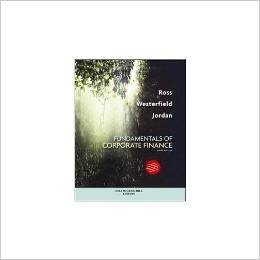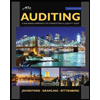
Fundamentals Of Corporate Finance, Tenth Standard Edition
10th Edition
ISBN: 9781121571938
Author: Westerfield, Jordan, 2013 Ross
Publisher: Mcgraw-Hill
expand_more
expand_more
format_list_bulleted
Question
Chapter 19, Problem 19.1CTF
Summary Introduction
To discuss: The definition of cash management.
Introduction:
The fundamental objective of cash management is to maintain the adequate cash investment and simultaneously the firm’s operation are also maintained effectively and efficiently.
Expert Solution & Answer
Explanation of Solution
Cash management indicates a broad area of finance that refers to the process of handling and using of cash in the business. It includes evaluating the cash flow, market liquidity, and investments.
Conclusion
Cash management is necessary because the businesses are motivated to hold cash for speculation, precaution, and for carrying out business-related transactions.
Want to see more full solutions like this?
Subscribe now to access step-by-step solutions to millions of textbook problems written by subject matter experts!
Students have asked these similar questions
What is the difference between a bond's coupon rate and its yield to maturity (YTM)?no AI
What is the difference between a bond's coupon rate and its yield to maturity (YTM)?
What is the difference between a bond's coupon rate and its yield to maturity (YTM)? Need help
Chapter 19 Solutions
Fundamentals Of Corporate Finance, Tenth Standard Edition
Ch. 19.1 - What is the transaction motive, and how does it...Ch. 19.1 - What is the cost to the firm of holding excess...Ch. 19.2 - Which would a firm be most interested in reducing,...Ch. 19.2 - Prob. 19.2BCQCh. 19.2 - Prob. 19.2CCQCh. 19.3 - Prob. 19.3ACQCh. 19.3 - Prob. 19.3BCQCh. 19.4 - Prob. 19.4ACQCh. 19.4 - What is a zero-balance account? What is the...Ch. 19.5 - What are some reasons why firms find themselves...
Ch. 19.5 - Prob. 19.5BCQCh. 19.5 - Why are money market preferred stocks an...Ch. 19.A - Prob. 1ACQCh. 19.A - Prob. 1BCQCh. 19.A - Prob. 1CCQCh. 19.A - Prob. 1QPCh. 19.A - Prob. 2QPCh. 19.A - Prob. 3QPCh. 19.A - Prob. 4QPCh. 19.A - Prob. 5QPCh. 19.A - Prob. 6QPCh. 19.A - Prob. 7QPCh. 19.A - Prob. 8QPCh. 19.A - Prob. 9QPCh. 19.A - Prob. 10QPCh. 19 - Prob. 19.1CTFCh. 19 - Prob. 19.2CTFCh. 19 - Prob. 19.3CTFCh. 19 - Prob. 1CRCTCh. 19 - Prob. 2CRCTCh. 19 - Prob. 3CRCTCh. 19 - Prob. 4CRCTCh. 19 - Prob. 5CRCTCh. 19 - Prob. 6CRCTCh. 19 - Collection and Disbursement Floats [LO1] Which...Ch. 19 - Prob. 8CRCTCh. 19 - Prob. 9CRCTCh. 19 - Prob. 10CRCTCh. 19 - Prob. 11CRCTCh. 19 - Prob. 12CRCTCh. 19 - Prob. 13CRCTCh. 19 - Prob. 1QPCh. 19 - Prob. 2QPCh. 19 - Prob. 3QPCh. 19 - Prob. 4QPCh. 19 - Prob. 5QPCh. 19 - Prob. 6QPCh. 19 - Prob. 7QPCh. 19 - Prob. 8QPCh. 19 - Prob. 9QPCh. 19 - Prob. 10QPCh. 19 - Prob. 11QPCh. 19 - Prob. 12QPCh. 19 - Prob. 1MCh. 19 - Prob. 2MCh. 19 - Prob. 3M
Knowledge Booster
Similar questions
- How do you calculate the net present value (NPV) of a project, and what does it indicate? Need helparrow_forwardHow do you calculate the net present value (NPV) of a project, and what does it indicate?arrow_forwardHow do you calculate the internal rate of return (IRR) for an investment, and what does it represent?helparrow_forward
arrow_back_ios
SEE MORE QUESTIONS
arrow_forward_ios
Recommended textbooks for you
 Auditing: A Risk Based-Approach to Conducting a Q...AccountingISBN:9781305080577Author:Karla M Johnstone, Audrey A. Gramling, Larry E. RittenbergPublisher:South-Western College Pub
Auditing: A Risk Based-Approach to Conducting a Q...AccountingISBN:9781305080577Author:Karla M Johnstone, Audrey A. Gramling, Larry E. RittenbergPublisher:South-Western College Pub

Auditing: A Risk Based-Approach to Conducting a Q...
Accounting
ISBN:9781305080577
Author:Karla M Johnstone, Audrey A. Gramling, Larry E. Rittenberg
Publisher:South-Western College Pub